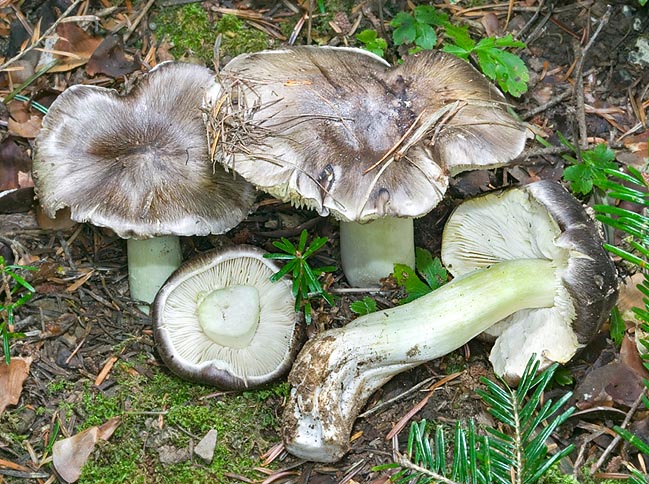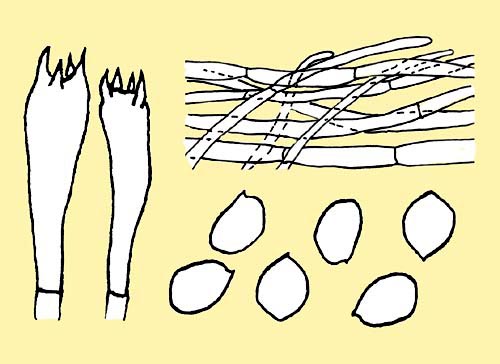
Text © Pierluigi Angeli

English translation by Mario Beltramini

Tricholoma portentosum is an excellent edible. In fact, it was named “portentous” for its flavor © G. Mazza
Family: Tricholomataceae R. Heim ex Pouzar, 1983.
Genus: Tricholoma (Fries) Staude, 1857.
Section: Equestria Konrad & Moublanc.
Stirp: Portentosum (Fries) Quélet.
Tricholoma portentosum (Fries) Quélet, 1873.
The name comes from the Latin “portentosus” = portentous, more referred to its goodness than to its look.
For the description of the genus, please refer to Tricholoma columbetta.
Description of the Section and the Stirp
To the Section Equestria are ascribed small and medium-sized fungi having the cap smooth, dry, oily or sticky, squamulose and scaly or sericious-fibrillary. The colour is variable, goes from the white to the yellow, to the olive-yellow, with several hues difficult to define. The stem is dry, sticky or oily, smooth, white, yellow or olive yellow. The flesh is more or less white, with a sub-farinaceous smell and gentle flavour, slightly bitter or sub-farinaceous. To the Stirp Porterntosum are ascribed medium-small sized fungi, with much fibrillose cap of grey colour, metallic grey or blackish grey, at times spotted of white or ochre white. The gills and the stem have yellow shades.
Description of the species
Cap: 5-8 (12) cm, initially conical-campanulate, then convex and finally flat, corrugated, wide and obtuse umbo; curved (non inrolled) margin, then extended, lobed, fissured, with the age it can be even revolute. The cuticle is partially separable, with radial fibrils, sticky and glossy when the weather is humid, sericious and bright when the same is dry, the colour is variable, steel grey, ochre grey, blackish grey, slate grey.
Hymenium: trimmed on the margin gills, little thick, wide and sinuous, intercalated by several lamellulas, the thread is irregular and at times serrate, white with yellow hues, greyish when mature.

Basidia, epicutis and spores of Tricholoma portentosum © Pierluigi Angeli
Stipe: 6-11 x 1,5-2 cm, cylindraceous, at times enlarged downwards, often curved laterally, robust, firm, full, then fibrous, fibrillose-semi glossy, whitish with slight yellowish shades, furfuraceous white at the apex.
Flesh: firm, compact, consistent in the cap, fibrous in the stipe, white, yellowish in the outer part, turns to greyish at the air, after long time. Floury and pleasant smell and taste.
Habitat: it grows in late autumn, preferably in the pine woods, but also in the mixed woods of spruce and beech or even in the pure beech wood.
Edibility: choice edible.
Microscopy: ovoid, guttulate, smooth spores, 5,5-6,05 × 4-4,4 µm. Clavate, tetrasporic basidia, without joints to buckle, 31,9-35, × 6,6-7,15 µm. Parallel trama with elongated hyphae wide from 5,5 to 9,9 µm. Epicutis formed by more or less parallel hyphae weakly gelatinous, wide from 3 to 6 µm.
Remarks: it is a not much big species, in spite of the name, as a matter of fact, the epithet “portentosum” was coined by Fries not due to its appearance, but due to its excellent organoleptic. It is a fungus growing in late autumn with a much variegated habitat, as it can be found under pure conifer (Pinus and Abies), but also in the mixed woods (Pinus and Fagus, Pinus and Castanea) but also in the pure beech woods or mixed with spruces (Fagus and Abies).
It is much sought for due to its organoleptic qualities. Due to the striated look of its cap, it might be mistaken with the Tricholoma virgatum (Fries : Fries) P. Kummer, which, however, has white or greyish stem and flesh having a sour or pungent taste. When, on the contrary, the cap is faded and the yellow hues do appear, it could be mistaken with the Tricholoma sejunctum (Sowerby : Fries) Quélet, which, however, has the flesh with bitter taste; with the Tricholoma josserandii Bon, which has the flesh smelling of bedbug and sour taste which, however, comes some time after the tasting.
Synonyms: Agaricus portentosus Fries 1821 (basionym); Gyrophila portentosa (Fries) Quélet 1886; Gyrophila sejuncta var. portentosa (Fries) Quélet 1896; Melanoleuca portentosa (Fries) Murrill 1914.
→ For general notions about Fungi please click here.
→ To appreciate the biodiversity of MUSHROOMS please click here.
